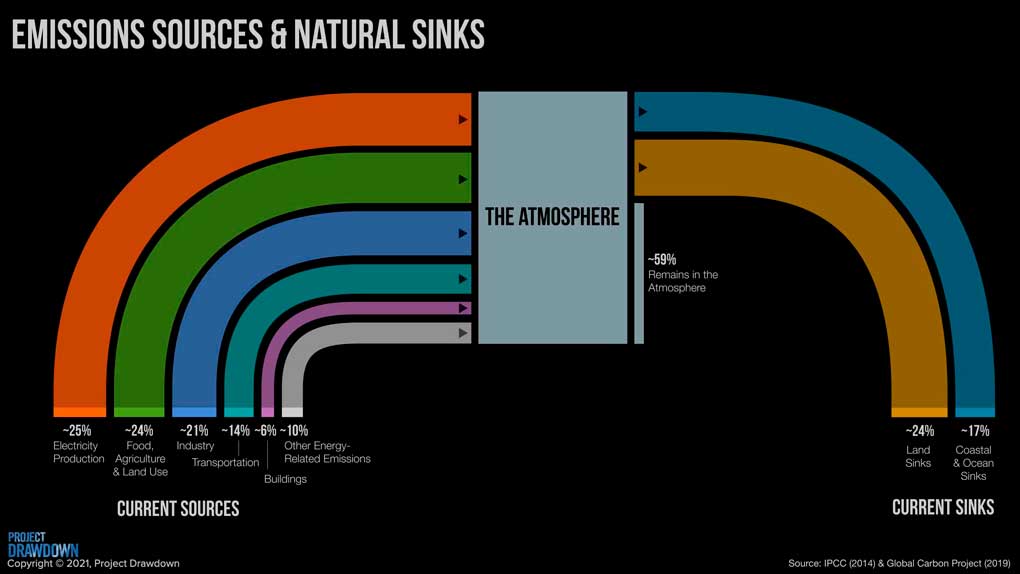Climate drawdown refers to the future point in time when levels of greenhouse gas concentrations in the atmosphere stop climbing and starts to decline. Drawdown is a milestone in reversing climate change and eventually reducing global average temperatures.
Project Drawdown refers to the nonprofit organization with the mission to help the world reach drawdown and stop catastrophic climate change quickly, safely, and equitably. In 2017, a publication titled “Drawdown” became a New York Times bestseller, where it highlighted and described different solutions and efforts available to help reach this goal.
Project Drawdown is a climate change mitigation project initiated by Paul Hawken and climate activist Amanda Joy Ravenhill.
The main principles of the project are to:
What are the sources of emissions to be reduced?
These are the sources of emissions along with the “sinks” that help to offset the emissions:

Another way to look at what we do:
| Area | Drawdown |
| Industry – Making things (cement, steel, plastic) | 21% |
| Electricity – Plugging in | 25% |
| Food, Agriculture –Growing things (plants, animals) | 24% |
| Transportation – Getting around (planes, trucks, cargo ships) | 14% |
| Buildings – Keeping warm and cool (heating, cooling, refrigeration) | 6% |
| Other | 10% |
| Total | 100% |
The sinks are two types
A. Trees and forests – They emit as much greenhouse gas as they absorb, so there shouldn’t be a large persistent net sink of greenhouse gases. Now because CO2 levels in the air are rising, causing kind of a fertilization effect. The world’s trees and the world’s oceans are now absorbing more CO2 bec ause there’s much more of it in the air than they’re used to. And that so-called kind of fertilization effect is driving sinks of carbon in our forests and our oceans above and beyond what’s normal for our planet. And that’s removing about half of the carbon dioxide emissions we’re putting in the air every year.
B Human caused sinks – And we call these anthropogenic sinks; These could be things that we do on land like planting trees or in the oceans like farming kelp, or maybe that machines that actually suck CO2 out of the atmosphere
2. This is a breakdown of each area :

3. Central to the project is the compilation of a list of the “most substantive solutions to global warming.” The list of 100, which encompasses only technologically viable existing solutions, was compiled by a team of more than 200 scholars, scientists, policymakers, business leaders, and activists and is now online.
80 solutions of the solutions could eliminate 1 trillion tons of CO2 from the atmosphere by 2050, enough to prevent the dangerous climate tipping point of 2 degrees Celsius. Moreover, these solutions would cost less than and produce more jobs than business as usual.
The team measured and modeled each solution’s carbon impact through the year 2050, its total and net cost to society, and its total lifetime savings. Project Drawdown uses different scenarios to assess what different changes to global climate efforts might look like. Scenario 1 shows a 2 °C temperature rise by 2100, while Scenario 2 shows a 1.5 °C temperature rise by 2100

Here is a list of the solutions with a link to the Drawdown library: Scenario 1 shows a 2 °C temperature rise by 2100, while Scenario 2 shows a 1.5 °C temperature rise by 2100
